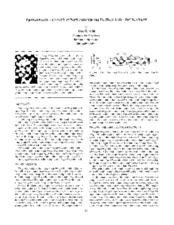| dc.contributor.other | International Pump Users Symposium (9th : 1992) | |
| dc.creator | Wild, Alan G. | |
| dc.date.accessioned | 2017-10-05T17:15:04Z | |
| dc.date.available | 2017-10-05T17:15:04Z | |
| dc.date.issued | 1992 | |
| dc.identifier.uri | https://hdl.handle.net/1969.1/164233 | |
| dc.description | Lecture | en |
| dc.description | pg. 111 | en |
| dc.description.abstract | The design and construction of progressing cavity pumps permits them to pump virtually any fluid from clean, low viscosity fluids like oil or water, to delicate products like whole cherries, to very abrasive, highly viscous fluids. Progressing cavity pumps use a single threaded rotor rolling eccentrically in a double threaded helix with a pitch length twice that of the rotor. This combination results in a series of sealed cavities 180 degrees apart that progress from the suction end to the discharge end of the stator, as the rotor rotates. As one cavity is closing, the other is opening at exactly the same rate so the sum of the two discharges is constant. The result is pulsationless flow without the use of valves. This makes the progressing cavity concept ideal for metering applications or other applications where predictable flowrates are essential. The primary focus herein on the proper selection of progressing cavity pumps for different types of applications. Applications discussed include the pumping of shear sensitive fluids, the pumping of extremely abrasive fluids, the pumping of a fluid in a metering application, and the pumping of a high viscosity fluid. | en |
| dc.format.medium | Electronic | en |
| dc.format.mimetype | application/pdf | |
| dc.language.iso | en | |
| dc.publisher | Turbomachinery Laboratories, Department of Mechanical Engineering, Texas A&M University | |
| dc.relation.ispartof | Proceedings of the 9th International Pump Users Symposium | en |
| dc.subject.lcsh | Pumping machinery | en |
| dc.title | Progressing Cavity Pumps - Proper Selection And Application | en |
| dc.type.genre | Presentation | en |
| dc.type.material | Text | en |
| dc.identifier.doi | https://doi.org/10.21423/R1ZQ3B | |


